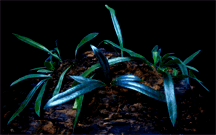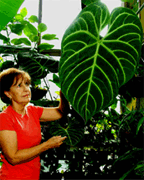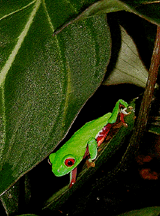![]()
Aroids and other genera in the Collection
Take the Tour Now?
Orchids
The
Exotic Rainforest
Can you grow plants under a green light source? Probably not for long! The plant simply can't effectively utilize that fraction of the spectrum, however, a closer look at what makes up light is necessary. There is actually no such thing as "white" light, the kind you see around you all day long. Go to the library, check out a physics book, and look up "acromatic color" for a better explanation of this bit of physical science. The "white" light you see is made up of three different wave lengths: blue, green and red. These are known as the primary colors. There is no such thing as yellow light either in the strictly technical sense and certainly no such thing as "black light". Black is simply the absence of light. All the other colors are generated by combinations of the three primary colors.
You probably don't realize it but when you type a search term into any search engine there are companies who are tracking what you ask. Not who you are, but what you are trying to discover. They make that information available to website webmasters so we can see what people are trying to learn and what brought you to this or any other website. I utilize one of those services so I can try to understand what people want to know about their plants. But don't be alarmed, I have no way of knowing who is looking for what! Recently someone somewhere in the world typed in a question to Google and asked "will green light kill plants"?I thought that was a very interesting question. And I wondered, why would anyone ask? But the answer is it very likely will!
 I'm a retired commercial
photographer. I used to be paid by major clients to photograph cruise
ships, resort hotels, clothing, boats, airliners and all sorts of other things
including tropical fish and girls in little bikinis since I used to work for dive magazines and shoot swimsuit
catalogues.
(click on the photo and you can see some of my commercial work) I use that as an example because taking photographs underwater is a
photographic challenge and requires specific knowledge of how light reacts. If
you don't understand light you are less likely to get a quality
photograph, especially beneath the surface. Light below the water is
very blue due to selective absorption and if you don't understand how to correct for that excess blue light
all the fish, and girls, will look blue on film! So I was
forced more than 30 years ago to learn about light and how it is
composed as well as how to manipulate and correct it's make-up.
I'm a retired commercial
photographer. I used to be paid by major clients to photograph cruise
ships, resort hotels, clothing, boats, airliners and all sorts of other things
including tropical fish and girls in little bikinis since I used to work for dive magazines and shoot swimsuit
catalogues.
(click on the photo and you can see some of my commercial work) I use that as an example because taking photographs underwater is a
photographic challenge and requires specific knowledge of how light reacts. If
you don't understand light you are less likely to get a quality
photograph, especially beneath the surface. Light below the water is
very blue due to selective absorption and if you don't understand how to correct for that excess blue light
all the fish, and girls, will look blue on film! So I was
forced more than 30 years ago to learn about light and how it is
composed as well as how to manipulate and correct it's make-up.
People love to take photographs in the morning and evening, at least they did before digital cameras came along! In the morning and late afternoon the sun's light has more red content because the other portions of the spectrum are being reflected away as a result of the Earth's angle in relation to the sun. When everyone used film in our cameras we loved that "warm" look because it made everything, and everyone, appear richer in the morning and late afternoon. Working photographers often make models get up before sunrise so they can benefit from that early morning color saturation. Sunsets and sunrises are (were) much more colorful and people look great (using film) because skin appeared "warmer". Typically you must use some sort of warming filter to get the same results with digital cameras since digital has built-in color regulating meters known as automatic "white balance". The cameras often automatically correct for the warmer morning light and try to make it appear "normal". But as the sun gets higher in the sky the light appears "white" because the full spectrum of blue, green and red light is present. Our eyes don't selectively see the colors, that requires a prism. But those three primary light colors, or various combinations of those colors, are present.
Have you ever noticed that many flowers don't open until the sun begins to rise in the sky? They are reacting to the presence of the full color spectrum. Have you ever noticed that leaves begin to change color and fall off the trees in the fall? They too are reacting to the changing color spectrum (more or less red and blue) along with the light's intensity. But people just see it as "white" light. Our brains have the ability to compensate so most of the time we don't notice the difference in the light's color known scientifically as color temperature. But inherently the plants are getting green light along with red and blue. But since the plant's leaves are green they reflect away the green portion of the spectrum and use little if any. Too much of any one portion of the spectrum may be bad for some living organisms while others crave only a certain spectrum.
Coral reefs love blue light. Corals actually use the blue light created when the water filters away the red first and then the green to feed an organism within their tissues. By the time a diver gets down to 50 or 60 feet the only portion of the light spectrum left in the water is blue! If you try to take underwater photos without a corrected flash attachment you'll quickly see the result! That organism in the coral needs blue light to produce sugars which in turn feed the corals. Few corals actually "eat" much of anything in the ocean. Effectively, they are largely being fed sugar by an algae living inside the tiny coral polyp which through photosynthesis utilize the blue spectrum. If you happen to be a coral reef aquarium keeper you already know this! That's why you added those actinic blue lights to your aquarium.
Plants appear to be the same way, at least to
some extent. Many plants don't like brilliant strong sunlight. Some do,
like Musa sp. (bananas) and a bunch of other sun loving plants.  The thing
they crave more than the color is the intensity. Most plants need a
fairly specific intensity of light (orchids are a good example) in to grow, live, and flower. That's
why many Philodendron sp. will live in your home in relatively low light
levels and grow adequately well. However, if allowed to reach
brigher light a Philodendron will become much larger than the
juvenile plant you grow in your home. They don't need as strong a light
source as the banana "tree". But some need much brighter light. A few,
such as Microsorum thailandicum, the iridescent blue fern
(Microsorum
thailandicum) actually prosper in very low light levels. If they get
what they want (dim blue light) they will reward you by turning a
beautifully dark iridescent blue! Give them too much light and they
just stay green.
The thing
they crave more than the color is the intensity. Most plants need a
fairly specific intensity of light (orchids are a good example) in to grow, live, and flower. That's
why many Philodendron sp. will live in your home in relatively low light
levels and grow adequately well. However, if allowed to reach
brigher light a Philodendron will become much larger than the
juvenile plant you grow in your home. They don't need as strong a light
source as the banana "tree". But some need much brighter light. A few,
such as Microsorum thailandicum, the iridescent blue fern
(Microsorum
thailandicum) actually prosper in very low light levels. If they get
what they want (dim blue light) they will reward you by turning a
beautifully dark iridescent blue! Give them too much light and they
just stay green.
I suspect this question arose because of a question about the light bulbs that are commonly known as "grow lights". Or perhaps, someone wanted to do something ornamental and display plants under a green light bulb. There is no way of knowing why the question was originally asked. Those "grow bulbs" have visibly more blue in their spectrum. That is in part to simulate shady light which many "house plants" prefer. Fluorescent lights in general have more blue light and that's why if you take a photo with a film camera under fluorescent light everything generally looks awful. A trained photographer adds a red correction filter to either the light source or the camera lens to help alter that "awful" coloration. But what is missing in fluorescent light is largely the red spectrum. The green is still there along with the blue. Interestingly, your eyes never seem to miss the absence of the red spectrum and consider fluorescent light still to be "white". Your brain simply makes a visual compensation without you realizing it has happened.
Many plants
appear to need the blue, and possibly red, portions of the spectrum
more. You can
go and spend $500 or more and a color meter if you want to
experiment with this, but unless you're a well paid photographer it
likely will serve little purpose.
 Experimentation will teach you the
same lessons with light. I once tried growing philodendrons and
orchids under an
incandescent lamp. Didn't work. All of them began to die. That's
because incandescent light bulbs, the kind you use most of the time in
your lamps and ceiling lights, are actually red light sources. If you
measure them in Degrees of Kelvin Temperature which in theory measures
the color of light from zero to 10,000 degrees (a method used by
trained photographers) you'll find incandescent light bulbs are around 3200
to 4000 degrees K (Kelvin). That's red. Fluorescent lights measure
closer to 7000 to 8000 degrees K. That's blue. Grow bulbs
tend to be more blue, but also just don't have a very strong intensity.
Experimentation will teach you the
same lessons with light. I once tried growing philodendrons and
orchids under an
incandescent lamp. Didn't work. All of them began to die. That's
because incandescent light bulbs, the kind you use most of the time in
your lamps and ceiling lights, are actually red light sources. If you
measure them in Degrees of Kelvin Temperature which in theory measures
the color of light from zero to 10,000 degrees (a method used by
trained photographers) you'll find incandescent light bulbs are around 3200
to 4000 degrees K (Kelvin). That's red. Fluorescent lights measure
closer to 7000 to 8000 degrees K. That's blue. Grow bulbs
tend to be more blue, but also just don't have a very strong intensity.
I don't think you can find a reference to the color temperature of green light because it is an element of the composition of "white" light. It takes all three (red, blue, green) to make "white" light. Again, go read a good text regarding acromatic color. (Have you ever wondered why stage foot lighting is red, blue and green?) If you add green light to the lower temperature red light it just becomes less red. And if you add green light to the higher Kelvin temperature blue light you just get light that is less blue. There is no need to measure the color temperature of the green spectrum because it can be seen in the temperature of the warmer (or less warm) and bluer (or less blue) light sources. I'm sure it exists in some lab somewhere, but is of no value, at least to photographers, since they can easily see the effect as the color temp of daylight tends towards "white" which is somewhere around 5600 degrees K.
 I'm
sure plants need the red
light since it is a part of the entire spectrum. But I also suspect they
don't need an excess of red light which is why many plants will begin to
die if grown only under an incandescent light source. Perhaps the
question should have been "will red light kill plants"? And the
answer is likely too much of any single color source is not great for
plants unless the excess tends to be blue. They need the entire spectrum,
they just don't use the green since they are already green and reflect
that spectrum away. You just need
to learn how much of any spectrum, especially the intensity, they need in
to prosper. But plants don't appear scientifically to
utilize the green spectrum.
I'm
sure plants need the red
light since it is a part of the entire spectrum. But I also suspect they
don't need an excess of red light which is why many plants will begin to
die if grown only under an incandescent light source. Perhaps the
question should have been "will red light kill plants"? And the
answer is likely too much of any single color source is not great for
plants unless the excess tends to be blue. They need the entire spectrum,
they just don't use the green since they are already green and reflect
that spectrum away. You just need
to learn how much of any spectrum, especially the intensity, they need in
to prosper. But plants don't appear scientifically to
utilize the green spectrum.
Daniel Mosquin of the University of British
Columbia Botanical Garden provided this important information regarding
the use of green light and chlorophyll a: "It may
not kill
them, depending on the relative amount of other accessory pigments, but
it will certainly make them suffer, since chlorophyll a absorbs
very little light
in the green
part of the spectrum: see
The Spectrum and Photosynthesis":
"Chlorophyll
does not absorb all the wavelengths of visible light equally.
Chlorophyll a, the most important light-absorbing pigment in
plants, does not absorb light in the green part of the spectrum. Light
in this range of wavelengths is reflected. This is the reason why
chlorophyll is green and also why plants (which contain a lot of
chlorophyll) are also green."
Another reader
of my post on the UBC garden website regarding this subject responded with this link:
http://www.uic.edu/classes/bios/bios...4am/lect10.htm
Both links explain why plants need light to survive and also why the leaves of plants are mostly green.
You can click on the underlined
links to read the entire discussion regarding photosynthesis or by just
continuing to read this article.
So will green light kill plants? I'm not a scientist, but I doubt it would be advisable to use only green light which I believe is what the original question was asking. I'm just not sure why they were asking. But since the leaves don't absorb and use the green spectrum, in time the plant is likely to suffer. They are green due to the chlorophyll in their own systems. Shade tends to be blue (people appear blue when photographed in deep shade with a film camera) which inherently contains green. Yet, many plants love shade so, just like corals, it must be the blue light spectrum they can utilize best.
I certainly wouldn't recommend trying to grow your plants under green "grow bulbs" if there even is such a device (or any other pure green light source) but I'd recommend you be more concerned with finding out what intensity of light your plant needs to flourish. I find far too many people try to grow plants in too little light because they are often sold as "house plants". House plants don't appear to be able to utilize very much, if any, of the light we know as "green light". "House plant" or not, they need what they need and if you plan to grow them you need to find out what that light level is and attempt to approximate the value.
One of my daughters once tried to grow a sun loving palm in the
corner of her living room. Guess what, it died! I get emails all the
time from people who can't get their orchids to bloom in the living
room. Guess why? Despite what most people believe,
orchids
need fairly bright light! I try in most of my plant descriptions
on this website to
explain
what strength of light we grow our plants. If I find one not
flourishing in the intensity where I currently have it placed I move it
to either a brighter or dimmer location.
I
In green plants and some other organisms including algae and specialized bacteria, photosynthesis is a chemical reaction caused by the interaction of chlorophyll within the plant and the sun's light combined with carbon dioxide, inorganic salts and water to produce carbohydrates. In green plants the autotrophic process converts physical energy from sun light into carbohydrates in the form of sugars through CO2 reduction. The biological term reduction indicates the hydrogen is molecularly stripped away from the oxygen.
These sugars are produced for the purpose of providing energy and food to the plant, thus growth. Most forms of photosynthesis release oxygen to the atmosphere as a byproduct Chlorophyll is the green pigment in every plant that captures sunlight to produce photosynthesis. Plants survive due to photosynthesis and draw in carbon dioxide through their leaves and utilizing a process known as being an autotroph they combine CO2 with water that enters the cells of the leaf as a result of rainfall. Autotrophs including create their own food by utilizing photosynthesis. If kept in very dim light you are deliberately starving the plants from the ability to produce their own natural sources of food. The process is also known in science as CO2 Fixation or the PCR Cycle (Photosynthetic Carbon Reduction) and in excessively dim light the process of photosynthesis can be switched off.
The process is completed through reduction (stripping away) of carbon dioxide by adding the hydrogen component of water (H2O) to create organic compounds. Reduction indicates the hydrogen is removed from the oxygen in H2O by specialized cells in the leaves. In green plants an autotroph converts physical energy from sun light into carbohydrates in the form of sugars. They may also form chemical energy by synthesizing complex organic compounds from simple inorganic materials in order to produce fats and proteins from light.
The products of photosynthesis produced in the leaf are both sugar and oxygen and the oxygen is given back to the environment while the carbohydrates are used to feed the plant's own growth. Home growers often recommend certain plants for this very reason since they feel it will improve the oxygen level in a room, which is not fully founded in science.
Although home growers rarely understand or just ignore the need for brighter light and high humidity to grow their plants, stronger light and misting are important to healthy growth. The next time anyone tells you dim light helps this plant or misting is not important since the water evaporates too quickly, recommend they read up on "autotrophic" growth and photosynthesis. It should also be understood plants also need oxygen and draw it in through their roots as will be explained later in this article. For a detailed explanation of the process of CO2 reduction and photosynthesis seek a copy of Photobiology of Higher Plants by Maurice S. McDonald in your local library.
Now, hopefully that same person will try to find the answer again!